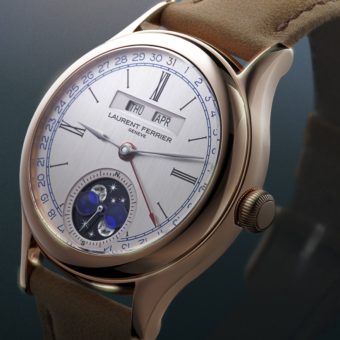
Montblanc introduced the Meisterstück fountain pen 90 years ago. With a deep black finish, gold rings and clip, a cap inlaid with the Montblanc star emblem, and a handcrafted nib, the pen became a famous status symbol. The brand launched the Meisterstück Heritage Collection of timepieces to mark the 90th birthday of this iconic writing instrument. We take a closer look at the collection’s perpetual calendar model.
Montblanc brought out its first collection of watches in 1997 and named them after its celebrated pen (meisterstück is German for “masterpiece”). To commemorate the pen’s 90th birthday, Montblanc has introduced a family of four new watches, the Meisterstück Heritage Collection. Among them is the Meisterstück Heritage Perpetual Calendar, which contains an SW 300-1 automatic base movement from Sellita enhanced with a Dubois Dépraz module.

The Perpetual Calendar’s case is made of 5N rose gold. It is 39 mm in diameter and 10.3 mm thick and has a slender, highly polished bezel. Its straight, vertical mid-section is decorated with a fine satin finish. Short lugs attach a black, lightly padded alligator strap that has a rose-gold pronged buckle. The watch weighs just 79.5 grams. It fits snugly and comfortably on the wrist. The highly polished caseback has four screws, also highly polished, and a sapphire window. Inscribed on the caseback are the level of water resistance, 3 bar, or 30 meters; and the case material, “Au750,” or 18k gold. The Montblanc name between the lugs at 12 o’clock is quite prominent; the engraved “Meisterstück Heritage” at 6 o’clock seems less significant in comparison, especially in light of previous Meisterstück models, which had a rather flashy “Meisterstück” engraving along the left side of the case. The case of the Meisterstück Heritage series looks much more refined.
Several inset buttons on both sides of the case are used to adjust the calendar mechanism. One button near 4 o’clock advances the moon-phase display, while another near 8 o’clock is used for the day of the week, and the one between 10 and 11 o’clock is used for the month display. A button at 10 o’clock advances the date and day simultaneously. If these indications are not in sync, you must first set the date and then the day using the button at 8 o’clock. The crown, of a new design, shows the Montblanc star in elegant polished relief on a matte sandblasted background instead of as a white inlay, as on other Montblanc watches. The crown is rather small but can still be readily grasped and turned thanks to prominent grooves around its edge. It is also easy to use your fingernail to pull the crown to the time-setting position; however, you may pass over another crown position without noticing. The crown hangs slightly below the mid-section of the case, which also makes operation simpler. There is a hack mechanism for the time-setting position, despite the lack of a seconds hand. (Montblanc had this indication replaced by Dubois Dépraz.) We noticed that the stem turned out of round during winding and setting, although this had no negative effect during our review.
The dial has a silver-white background with a delicate sunburst pattern that varies in appearance depending on the angle and intensity of the light. The perpetual calendar is displayed on several subdials. The day and date are printed in black on inset rings: the day at 9 o’clock is shown as English abbreviations and the date at 3 o’clock alternates as Arabic numerals for the odd-numbered days and as black dots for the even-numbered ones. By contrast, the abbreviations for the months at 12 o’clock and the display for the moon-phase at 6 o’clock are printed directly on the dial. A small arrow set on a lower level within the month ring turns to indicate the leap year. The first three years are printed in black with the leap year shown as a red 4. Divisions between the years are simple black lines.

A blue moon-phase disk with a golden moon and stars turns beneath a double-arc opening in the dial at 6 o’clock. The other calendar indicators feature blued steel hands while gold-plated, faceted dauphine hands point to the time. The hours are marked with faceted applied indexes, gold plated and streamlined, in three different lengths. The markers at 3, 6 and 9 o’clock are shortened to leave room for the calendar dials and the logo. Along with the Roman numeral 12, this results in a well-balanced circular display. Each applied marker is firmly fastened to the dial at two points. The minutes markers are printed along the outer rim of the dial, which is slightly curved to the outside to make them more visible. The resulting look, including the slightly curved sapphire crystal, recalls classic 1950s designs.

Once a perpetual calendar is correctly set and running, it will always show the correct date. Although a standard calendar will need to be reset at the end of months shorter than 31 days, a perpetual calendar “knows” how long each month is and adjusts itself accordingly. Only in the year 2100 will the calendar need to be reset, assuming the watch is kept running continuously until then (an unlikely proposition). If (or, rather, when) the watch stops running before 2100, you can adjust the calendar using the inset buttons as described above – a simple process when you use a correction stylus. The moon-phase display requires more attention: it will need to be reset after 2.5 years. Montblanc has named its Sellita/ Dubois Dépraz movement Caliber MB29.15. The Sellita 300, an alternative to the ETA 2892, has been on the market for just five years, so modifications to it are still rather rare. The calendar module has been in existence somewhat longer and has been modified for Montblanc. Changes were made in the month display and, in this version, the leap-year cycle.
Montblanc’s month display shows one entire year. The four-year leap-year indicator advances at the first of each month. Unfortunately, on our timepiece, an error was made when this disk was set. The leap-year arrow did not point to the correct spot on the four-year circle. Calendar functions are always driven by the hour wheel. Because this wheel makes two complete rotations each day while the calendar advances only once in 24 hours, the calendar mechanism requires a transmission gear. This wheel moves a complex system of gears, levers, springs and clicks that advance the date, day, month and year as well as the moon-phase display. The Dubois Dépraz calendar module in the perpetual calendar is a “continuously rotating” type, which means that the calendar functions (date, day and month) are not advanced instantaneously via a large yoke (i.e., a jumping perpetual calendar), but rather via continuously rotating wheels. The hands move at two different speeds, first slowly and then suddenly, and not necessarily simultaneously – a real pleasure to watch.

other Montblanc watches, but polished gold against a matte background.
While the transmission wheel is turning, a cam mounted on top slowly begins advancing the lever for the calendar system. On the dial side, the movement of the day-display hand is easiest to see since it only has seven reference points for each of the days on a relatively large display. The day hand begins slowly advancing at around 10:30 p.m. The date hand begins to move a half hour later. Its movement is more difficult to see because the dial shows 31 days. The month is advanced via the 48-hour disk. Here, too, it begins slowly and then jumps. Except for the incorrectly placed leap-year disk, every mechanism functioned well, regardless of whether the calendar advanced from July 31 to August 1 or from February 28 to March 1. The latter action takes a bit longer and begins at around 7:00 p.m. with the date advancing from the 28th to the (non-existent) 29th and ends, like the other actions, around 12:30 a.m. The date wheel is advanced every 24 hours. This wheel also has a stepped cam; a click falls over it at the end of the month and advances the date accordingly. The information on whether to advance one day or several comes from the stepped cam. A lever on this cam determines when to start the advance and also pushes the cam ahead.
Montblanc says that all its perpetual calendars are subjected to 500 hours of quality-control testing to check their function and rate. This very first model, a prototype, may not have undergone the full testing process; otherwise the testers should have detected the incorrectly placed leap-year disk. The rate results could also use some improvement. In its fully wound state its rates remain steady but after only a short period of time (six hours), they fall off considerably, especially in the dial up and crown down positions. One would expect similar results when the watch is worn on the wrist, but this could not be tested accurately due to the lack of a seconds hand. Despite these faults, the perpetual calendar from the new Meisterstück Heritage collection has plenty going for it. Its price alone is attractive, especially in this era of super-expensive luxury watches. And so is its styling, at once classical and distinctive.

dauphine hands and applied markers.
Manufacturer: Montblanc Montre S.A., Chemin des Tourelles, CH-2400 Le Locle, Switzerland
Reference number: 110714
Functions: Hours, minutes, perpetual calendar with date, day, month, leap year, moon-phase display
Movement: MB29.15, based on Sellita SW 300-1, automatic, 28,800 vph, gold-plated brass balance, Incabloc shock absorption, 25 jewels, diameter = 25.5 mm, height = 5.2 mm, 42-hour power reserve; perpetual calendar module by Dubois Dépraz
Case: 5N rose gold, curved sapphire crystal with nonreflective coating, sapphire window in caseback, water resistant to 30 m
Strap and clasp: Alligator strap with 5N rose-gold pronged buckle
Rate results (Deviations in seconds per 24 hours):
(Fully wound/after 24 hours)
Dial up -0.2 / -7.4
Dial down +4.3 / -2.9
Crown up -5.0 / -9.1
Crown down +1.3 / -4.9
Crown left +1.8 / -1.0
Greatest deviation of rate 9.3 / 8.1
Average deviation +0.4 / -5.1
Average amplitude:
Flat positions 301° / 268°
Hanging positions 269° / 238°
Dimensions: Diameter = 39 mm, height = 10.3 mm, weight = 79.5 g
Variations: Stainless steel ($12,800)
Price: $21,600
This article first appeared in the August, 2014 issue of WatchTime Magazine.






